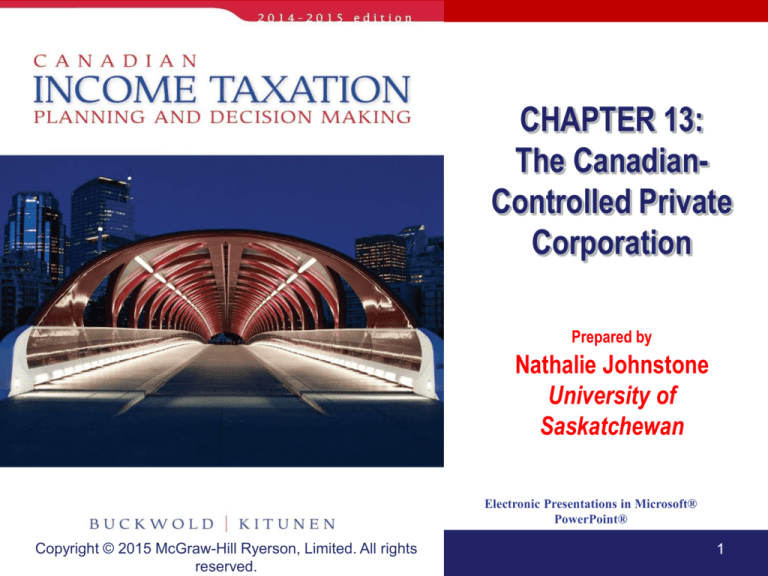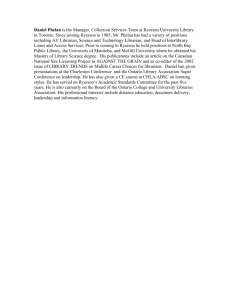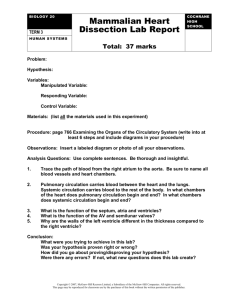
CHAPTER 13:
The CanadianControlled Private
Corporation
Prepared by
Nathalie Johnstone
University of
Saskatchewan
Electronic Presentations in Microsoft®
PowerPoint®
Copyright © 2015 McGraw-Hill Ryerson, Limited. All rights
reserved.
1
The Canadian-Controlled Private
Corporation
I.
II.
III.
IV.
V.
VI.
VII.
Definition and Basic Principles
Taxation of Income Earned by a CCPC
Benefits of Incorporation
Dividend Policy
Loans to Shareholders
Limitation of the Small Business Deduction
Overall Tax Calculation for a CCPC
Copyright © 2015 McGraw-Hill Ryerson, Limited. All rights reserved.
2
I. Definition and Basic Principles
• A private corporation that is not controlled
by:
– a public corporation or
– a non-resident of Canada.
• CCPCs are distinguished in three basic
ways:
– rates of tax,
– double taxation, and
– secondary relationships.
Copyright © 2015 McGraw-Hill Ryerson, Limited. All rights reserved.
3
Rates of Tax
• There are different rates of tax for different levels
of income.
• First $500,000 of annual active business income
is subject to a reduced rate of tax.
– Lower than other corporation and
– Substantially lower than majority of personal tax rates
Copyright © 2015 McGraw-Hill Ryerson, Limited. All rights reserved.
4
II. Taxation of Income Earned by a
CCPC
Net income for tax purposes must be allocated
into five areas before taxes can be computed:
1. Active business income
2. Specified investment business income
3. Capital gains
4. Personal services business income
5. Dividends
Copyright © 2015 McGraw-Hill Ryerson, Limited. All rights reserved.
5
Active Business Income (“ABI”)
• Def’n- business income from any business
carried on by the corporation other than:
– a specified investment business and (rents, interest,
taxable capital gains and other passive income)
– a personal services business.(an incorporated
employee)
• First $500,000 x 17% - in 2014 (federal tax)
– Referred to as the small business deduction (SBD).
• The $500,000 SBD limit is an annual amount;
– if unused, cannot be carried over to other years.
Copyright © 2015 McGraw-Hill Ryerson, Limited. All rights reserved.
6
Specified Investment Business Income
Two arbitrary exceptions:
1. Rental income that is derived from the leasing of
movable property (vehicles and equipment) is
considered to be active business income.
2. ITA 125(7) - Other property income is considered to be
active business income only if the corporation employs
more than five full-time employees to generate that
income.
Copyright © 2015 McGraw-Hill Ryerson, Limited. All rights reserved.
7
Tax Treatment of Specified Investment
Business Income
• Disqualified as ABI:
– is not entitled to the SBD or
– the 13% (2010) special reduction.
• In addition a special refundable tax of 6 2/3%
must be paid.
• This special refundable tax is fully refundable to
the corporation upon payment of dividends.
Copyright © 2015 McGraw-Hill Ryerson, Limited. All rights reserved.
8
Tax Treatment of Specified Investment
Business Income
• All property income subject to high tax rate is
entitled to a tax refund of 26 2/3%.
• Means when a corporate tax rate = 44 2/3%
Effective Tax rate =
(38%+6 2/3% -26 2/3%) = 18%
Copyright © 2015 McGraw-Hill Ryerson, Limited. All rights reserved.
9
Combined Tax on Property Income
Corporate income (rent, interest, etc)
$1,000
Corporate Tax @ 38%
(380)
Special Refundable Tax @ 6 2/3%
(67)
Potential refund when paying dividend @
26 2/3% x $1,000
267
Total Available for dividend
$820
Shareholder income (dividend)
$ 820
Tax (net of tax credit)
(287)
Total after tax cash
$ 533
Total tax paid
Corporation $180
Shareholder
287
Total combined tax rate
Copyright © 2015 McGraw-Hill Ryerson, Limited. All rights reserved.
$467
47%
10
Capital Gains
• Taxable capital gains treated the same as
specified investment business income.
• Capital Dividend: IT IS TAX FREE!!!!!!!!!!!!
– a mechanism to avoid double taxation on capital
gains,
– distributes the tax-free portion of the gain to the
shareholders
– An election is required
Copyright © 2015 McGraw-Hill Ryerson, Limited. All rights reserved.
11
Personal Services Business (“PSB”)
Income
• A PSB is a business that provides services,
– person providing the services is a specified
shareholder(owns >10% shares) of the corporation, and
– The relationship between the person providing the
services and the entity receiving the services is of an
employment nature.
• Not eligible for the SBD on that income, and
• Faces significant restrictions on deductions.
• No employment relationships = business income
is ABI
Copyright © 2015 McGraw-Hill Ryerson, Limited. All rights reserved.
12
Dividends
• Taxable Canadian dividends received by a
CCPC are subject to PART IV TAXES.
• The amount of Part IV taxes depends on the
degree of ownership.
Copyright © 2015 McGraw-Hill Ryerson, Limited. All rights reserved.
13
Dividends Received from
Non-Connected Corporations
• Non-connected if:
Includes dividends
received from public
corporations
Private Corporations
< 10% voting shares
Other Corp
• Non-Connected Dividends received are taxed at
33 1/3% (Part IV tax) – of actual dividends
received but this tax is fully refundable upon
the payment of dividends
Copyright © 2015 McGraw-Hill Ryerson, Limited. All rights reserved.
14
Dividends Received from
Connected Corporations
• Connected if:
Includes dividends
received from public
corporations
Private Corporations
> 10% voting shares
Other Corp
• Connected Dividends not subject to Part IV tax, unless
• Paying corporation receives a refund of its Part IV tax,
– Receiving Corporation pays Part IV tax equal to its % of refund.
Copyright © 2015 McGraw-Hill Ryerson, Limited. All rights reserved.
15
III.
•
Benefits of Incorporation
The major benefits of incorporating are:
1.
2.
3.
4.
Tax deferral
Employment benefits
Flexibility in family ownership
Stabilization of annual income
Copyright © 2015 McGraw-Hill Ryerson, Limited. All rights reserved.
16
Tax Deferral –
The Small Business Deduction
Incorporating as a CCPC permits access to the
SBD on ABI.
-
benefit is a tax deferral – second level of tax on
corporate distribution to the shareholder or when the
shares are sold.
Shareholder
2nd level
of tax
-
CCPC - ABI
Deferring tax on ABI has two basic advantages:
1. Increased cash flow - lower taxes means more can be
reinvested, resulting in greater ultimate ROI.
2. Increased cash flow at early stages of a business reduces
risk of failure.
Copyright © 2015 McGraw-Hill Ryerson, Limited. All rights reserved.
17
Employment Benefits
• Shareholder:
• who participates in the management, and
• is entitled to receive compensation as an employee.
• Employment Benefits paid to
owner/manager:
- are fully deductible from the employer’s income
- May or may not be taxable to the employee (Give the
non-taxable employee benefits- RPP, Medical, noncash gifts…..etc.. From Chapter 4)
Copyright © 2015 McGraw-Hill Ryerson, Limited. All rights reserved.
18
Other Benefits
• Flexibility in Family Ownership/Legitimate Income
Splitting
- Bringing in family member as shareholders and employees – better
income splitting opportunities.
• Ability to utilize the $800,000 Capital gains deduction
• Estate planning opportunity to reduce taxes on
death
• Stabilization of Annual Income
- two-tier system of taxation, gives the shareholder the right to
choose when the second level of tax will occur.
- Flexibility permits the owner to fully utilize the progressive tax
rates imposed on individuals.
Copyright © 2015 McGraw-Hill Ryerson, Limited. All rights reserved.
19
Primary Disadvantages
of Incorporating
• Higher costs (lawyer, accounting fees..)
• Primary disadvantage relates to the
utilization of losses:
- Losses are locked within the corporation
- cannot be offset against income earned by the
shareholder
Copyright © 2015 McGraw-Hill Ryerson, Limited. All rights reserved.
20
Benefits of Incorporating Investments
• The incorporation of investment income and
capital gains does not result in substantial tax
advantages for the individual.
• Investments are taxed at the high corporate rate
• no substantial tax deferral occurs since:
Corporate tax
Personal
Approx. =
rate
tax rates
BUT SHOULD STILL CONSIDER DOING FOR
ASSET PROTECTION
Copyright © 2015 McGraw-Hill Ryerson, Limited. All rights reserved.
21
IV.Dividend Policy
Distributions – Dividends versus Salary:
• A CCPC managed by its shareholder can distribute
income by salary or dividends.
- The optimum combination and the timing of the
payments depends on:
- nature of the corporate income as well as
- both personal and corporate income levels.
-Difficult to establish a single policyRULE OF
THUMBSalary to reduce NI of corp <$500k, rest as
dividends. BUT
Keep in mind that if shareholder wants to accumulate
RRSP, then only salary gives eligibility to RRSP
Copyright © 2015 McGraw-Hill Ryerson, Limited. All rights reserved.
22
V. Loans to Shareholders
Permitted to loan funds to shareholders
provided:
- Shareholder is also an employee and
- loan is advanced due to the employment
relationship, for the following purposes:
1. To assist acquiring a personal residence.
2. To acquire treasury shares in the corporation.
3. To acquire an automobile to be used in performing
employment duties.
Copyright © 2015 McGraw-Hill Ryerson, Limited. All rights reserved.
23
V. Loans to Shareholders
- Loans for the above purposes have no tax
consequences,
- provided that the repayment terms are reasonable.
- There is no requirement that the loan bear
interest;
- However If no interest or low interest is charged
employee/shareholder will have a taxable
employment benefit = (CRA prescribed rates – Rtae
charged) x Loan balance (See Chapter 4)
Copyright © 2015 McGraw-Hill Ryerson, Limited. All rights reserved.
24
V. Loans to Shareholders
Loans for other reasons (then those
mentioned):
- must be repaid within one taxation year of the year in
which the advance was made; otherwise
- Full amount of the loan will be taxable to the
shareholder as business income.
- If these loans are later repaid, a deduction from
income is permitted in the year of repayment.
Copyright © 2015 McGraw-Hill Ryerson, Limited. All rights reserved.
25
V. Loans to Shareholders
S/H loan of $50,000 made in Jan 1, 2013 by INC. whose
year end is December.
1) Loan is to buy a car at 0 interest. Repayable $10,000
every Feb starting 2014.
Benefit in 2013 = 1% x 50,000 = $500 employment income
Benefit in 2014 = 1% x 40,000 = $400 employ inc. etc….
2) Loan is to buy furniture at 0 interest. S/H repays the full
amount in January, 2016
Consequences:
S/H 2013
Income inclusions
$50,000
S/H 2016
Income deduction
$50,000
Copyright © 2015 McGraw-Hill Ryerson, Limited. All rights reserved.
26
VI. Limitation of the Small Business
Deduction
Associated Corporations
- Two or more corporations must share the SBD of
$500,000 income limit.
- Owners can allocate this limit in any proportion desired
Copyright © 2015 McGraw-Hill Ryerson, Limited. All rights reserved.
27
Associated Corporations
Corp A
>50%
voting
Corp B
Shareholder or
group of shareholder
>50%
voting
>50%
voting
Corp C
Corp D
Copyright © 2015 McGraw-Hill Ryerson, Limited. All rights reserved.
28
Associated Corporations
Two Corporations are associated if:
• One of the corporation controlled the other
corporation
A
60%
B
60%
C
Copyright © 2015 McGraw-Hill Ryerson, Limited. All rights reserved.
29
VI.Overall Tax Calculation for a CCPC
Aggregate investment income:
- Canadian and foreign net property income:
- interest,
- rents,
- royalties,
- less related expenses
- net taxable capital gains (gains minus losses) for the current
year less any net capital losses from other years claimed in the
current year.
- Dividends from taxable Canadian corporations are excluded
from the definition.
Copyright © 2015 McGraw-Hill Ryerson, Limited. All rights reserved.
30
Summary Tax Calculation
Part I tax
Federal Tax
XXX
less Abatement (10%)
(XX)
Add Refundable tax 6 2/3%
XX
Less SBD (if applicable) 17%
(XX)
Less M&P (if applicable) 13%
(XX)
Less GRR (if applicable) 13%
(XX)
Less FTC (if applicable) IGNORE
(XX)
Less Political Tax Credit IGNORE
(XX)
Add Provincial Tax IGNORE
Total Part I tax (Federal and Provincial)
+PART IV TAXES
-LESS DIVIDEND REFUND
= TOTAL TAXES PAYABLE
XX
XXX
XXX
(XXX)
XXX
Copyright © 2015 McGraw-Hill Ryerson, Limited. All rights reserved.
31
Refundable Dividend Tax on Hand
(RDTOH)
• The RDTOH is designed to accumulate the
eligible tax refund that occurs when dividends
are paid to shareholders.
• The potential refund consists of all Part IV taxes
paid by the corporation plus 26 2/3% of all
investment income earned.
Copyright © 2015 McGraw-Hill Ryerson, Limited. All rights reserved.
32
RDTOH
Balance BOY
XX
ADD:
1. Part IV Tax Paid
XX
2. 26 2/3% X Investment income
XX
LESS Dividend refund of last year
Balance at end of year
(XX)
XX
DIVIDEND REFUND = LESSOR OF:
1/3 X DIVIDENDS PAID OR
ENDING BALANCE IN RDTOH
Copyright © 2015 McGraw-Hill Ryerson, Limited. All rights reserved.
33






